Most of the flutes on this page were custom made to the specification of our special customers. These are examples of the custom work that we have done. If you have an idea that might be considered “unusual,” let’s talk about how we might turn that idea into a very personal flute.
Custom Flutes from Turtle Mound Flutes
Entries in Flute Maker Competitions
These flutes were made to enter into flute maker competitions at major flute festivals.
| Name | Wood | Fetish | Key |
| Manatee - Musical Echoes 2011 | Black Palm | Sassafras | "Middle" Am |
| Tawodi (Red-Tailed Hawk) - Musical Echoes 2010 | Brown Ebony & Sassafras | Sassafras | "Middle" F#m |
| Tluhdatsi Hawinaditluh Gadohi (Underground Panthers) - Musical Echoes 2009 | Spalted Hackberry | Mesquite | "Middle" Dm |
| Uktena (Mythical River Serpent) - Oklahoma Flute Festival - 2008 | Spalted Hackberry | Walnut & Cocobolo | "Middle" Ebm |
| Wadaduga ("Dragonfly") - Musical Echoes 2008 | Red Cedar | Canary Wood & Walnut | "Middle" Em |
Custom Flutes for Customers
These flutes were made to the exacting specifications of our customers. I tell prospective custom flute customers to share their vision with me and let’s see if I can make it reality.
| Name | Wood | Fetish | Key |
| Sooty Tern | Cherry | Sassafras | "High" Em |
| Daksi ("Turtle") | Eastern Red Cedar | Mun Ebony | "Middle" Am |
| Nuhda ale Nuhda ("Sun & Moon") | Alaskan Yellow Cedar | Cocobolo | "Middle" Am |
| Orca/Eagle | Sassafras | Cocobolo | "Middle" Am |
| Peace Dragon | Eastern Red Cedar | Silver Maple | "Middle" Abm |
| "The Zoo" (6 Animals) | Eastern Red Cedar | Olivewood | "Middle" Gm |
| Daksi ("Turtle") | Red Cedar/Yellow Cedar/Cocobolo | Sassafras | "Middle" Gm |
| Golanuh ("Raven") | Red Cedar | Cocobolo | "Middle" Fm |
| Zuni Bear & Zia Sun | Ash/Cocobolo | East India Rosewood | "Middle" F#m |
| Griffin | Bocote | Osage Orange | "Middle" F#m |
| Horny Toad | Red Cedar/Cocobolo | Cocobolo | "Middle" F#m |
| Nuhnohi Udeti ("Roadrunner") | Alaskan Yellow Cedar | Tesota | "Middle" F#m |
| Kawonu ("Duck") & Kiakklo | Black Cherry | Mesquite | "Middle" F#m |
| Sogwili ("Horse") | Black Walnut/Oregon Myrtlewood | White Ash | "Middle" Em |
| Kokopelli | Red Cedar | Padauk | "Middle" Em |
| Uktena (Mythical River Serpent) | Black Walnut | Padauk | "Middle" Em |
| "ECHOES from the TRAIL" | Red Cedar | Honey Mesquite | "Middle" Ebm |
| Tsalagi Tsuniyuhwi (The Cherokee Clans) |
Red Cedar | Ash | "Middle" Dm |
| Pochteca Trader | Alaskan Yellow Cedar/Padauk | Silver Maple | "Middle" Dm |
| Metamorphosis | Alaskan Yellow Cedar | Cocobolo, ebony & sassafras | "Middle" Cm |
Entries in Flute Maker Competitions
These flutes were made as entries in festival flute maker competitions. They remain in my personal collection and are displayed as examples of my custom work. They always attract much attention and comments.
Because I have been the vice chair of the Native Rhythms Festival each year since the inaugural festival in 2009, I have been ineligible to enter the competition there. I have turned my interest to making a custom flute featuring that year’s theme/logo that went into the silent auction.
Manatee
This flute was created as my entry in the Flute Makers’ Competition at the 2011 Musical Echoes (at Ft. Walton Beach, FL; April 29 – June 1, 2011). The required theme, which had to be depicted somewhere on the flute, was the “manatee.” Apparently the manatee, indigenous to Florida, was not common to the Cherokee as I was unable to find a Cherokee word for it.
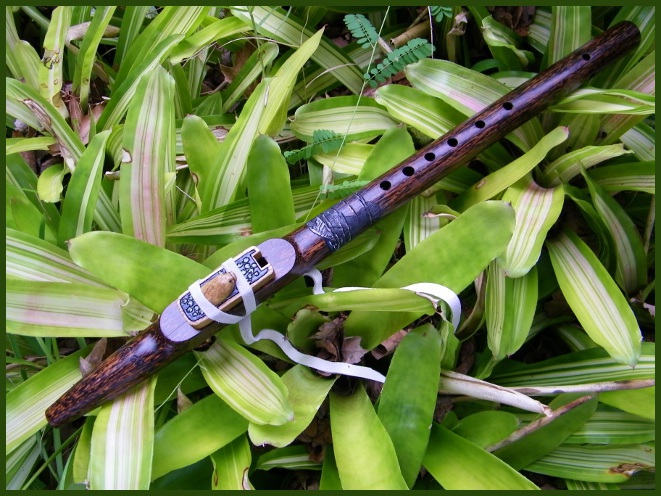



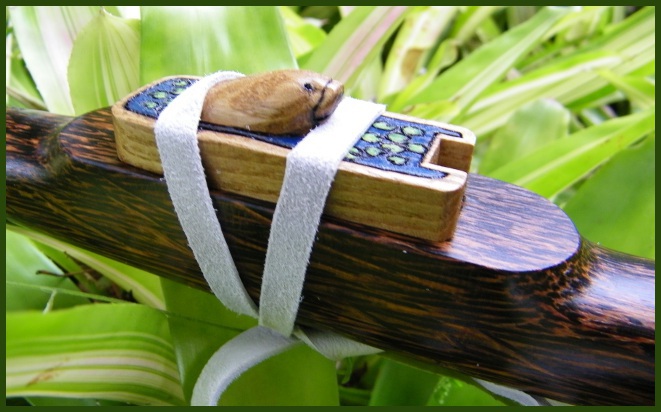
This beautiful black palm flute is tuned to the “middle” A minor pentatonic scale. The festival theme manatee is captured in the sassafras fetish depicting a young calf raising its head from a lily-pad filled pond, carved from a piece of sassafras. Just below the nest area is the image of a mature manatee with its head above water, and it’s body visible in the water. The black palm used in this flute comes from the Myanmar Republic (formerly known as Burma) in southeast Asia. Technically, this is not wood at all, but a member of the grass family. The beautiful grain comes from its high density, which also leads to its relatively heavy weight for its size. Extra care is needed when working black palm as it splinters very easily right up to the point where the finish is applied. (April 2011)

(Tawodi)
(Cherokee for "Hawk")
This flute was created as my entry in the Flute Makers’ Competition at the 2010 Musical Echoes (at Ft. Walton Beach, FL; April 23-25, 2010). The required theme, which had to be depicted somewhere on the flute, was the “red-tailed hawk.”

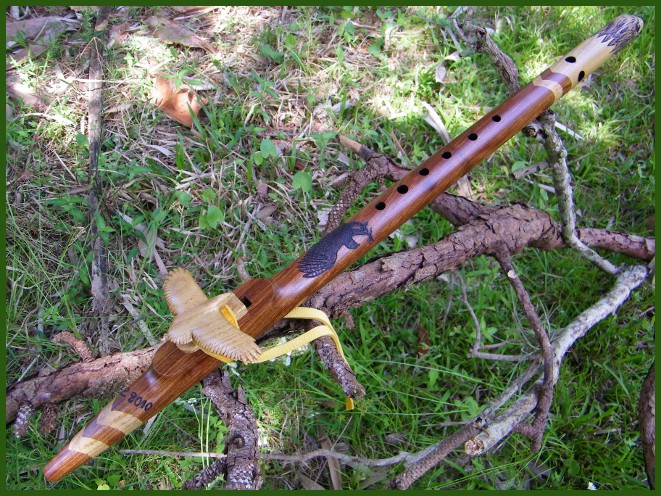




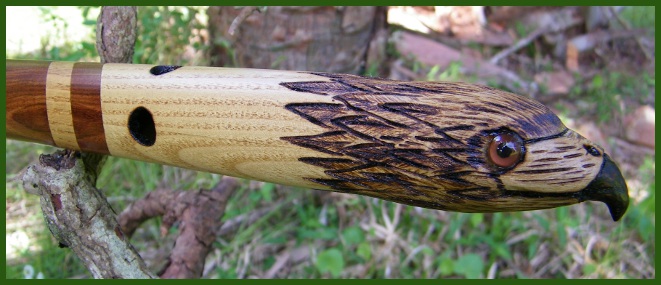
This beautiful brown ebony and sassafras flute is tuned to the “middle” F# minor pentatonic scale. The festival theme red-tailed hawk is captured in the sassafras carved hawk-in-flight fetish, an attacking hawk with talons extended burned into the flute body below the nest area, and the red-tail’s fierce head carved and burned into the single-piece sassafras endcap. The chevron-shaped accent rings, which have drawn considerable comment, are a first for Turtle Mound Flutes, as is the hawk’s head carving directly on the wood of the flute endcap. (April 2010)

(Tluhdatsi Hawinaditluh Gadohi)
(Cherokee for Underground Panthers)
This flute was created as my entry in the Flute Makers’ Competition at the 2009 Musical Echoes (at Ft. Walton Beach, FL; April 24-26, 2009). The required theme, which had to be depicted somewhere on the flute, was the “panther.” I chose to make this flute to tell the Cherokee legend of the “Underground Panthers”.
The Underground Panthers
A Cherokee Legend
Long ago a hunter was deep in the woods when he saw a panther approaching him on the path. Uncertain as to the intentions of Tluhdatsi [panther], the hunter readied an arrow in case Tluhdatsi should attack.
But as they came closer, Tluhdatsi said, “Osiyo [hello], tohitsu [how are you]?”
“Osda [good], nihina [and you]?” replied the hunter.
After an exchange of pleasantries, Tluhdatsi suggested, “I see that you too are hunting. Perhaps it would be beneficial for us to hunt awi [deer] together.” Sensing no danger, the hunter agreed.
After awhile, the man and the Tluhdatsi came upon a small doe. When the hunter readied an arrow and prepared to shoot, Tluhdatsi calmly spoke: “Tla [no], she is too small. We’ll find another.” On they went…
It wasn’t long before a nice buck appeared in the clearing ahead. The pair circled to the downwind side and cautiously approached their prey. Just as Tluhdatsi sprang, the buck bolted and the attack was only partially successful. A struggle ensued and it was with great difficulty that Tluhdatsi finally killed his prey. As the hunter approached to gather awi, Tluhdatsi said, “No, the animal is mangled. Leave him. He will make a fine meal for awaholi [eagle], suli [buzzard], and others. We’ll find another.”
Sure enough, a short time later they came upon another buck. This time Tluhdatsi‘s attack was swift and true. Then Tluhdatsi wrapped his tail around awi and threw him over his back. He turned to the hunter and said, “Come with me back to our camp and we will celebrate the kill together.”
The hunter agreed and off they went, deeper into the woods. After a time, they came to the side of a hill, when suddenly a door opened into the hill and Tluhdatsi entered, followed by his companion. Inside they found other panthers dancing around a fire. “Come, join us.” they said to the hunter. He did, and it was a joyous feeling.
After a few dances, the hunter said that it was getting late and he needed to return to his village. So Tluhdatsi opened the door in the side of the hill and the hunter departed alone. As he approached his village, he saw great commotion and a group of his friends came over to greet him.
“What is happening? What are you so excited about?” asked the hunter.
“We have formed search parties to go out to look for you,” said the leader. “You have been gone for days. We were sure that something had happened to you.”
“Days? I don’t understand. It has been just a few hours!”
Unable to explain the time discrepancy, the hunter returned to his village. But within a week, he died. You see, he had started to take on the characteristics of the panthers and could no longer live among people. If he had stayed with the panthers, he would have lived.


The hunter and the panther
stalk a deer.
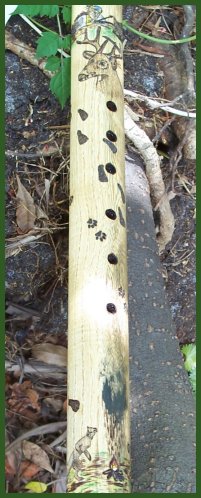
The tracks of the panther and the hunter’s moccasins show the trail to the panthers’ lair.

At the panthers’ lair, three
panthers are shown dancing
around the fire.

The stalking panther, preparing to strike, is also depicted in the carved mesquite fetish..
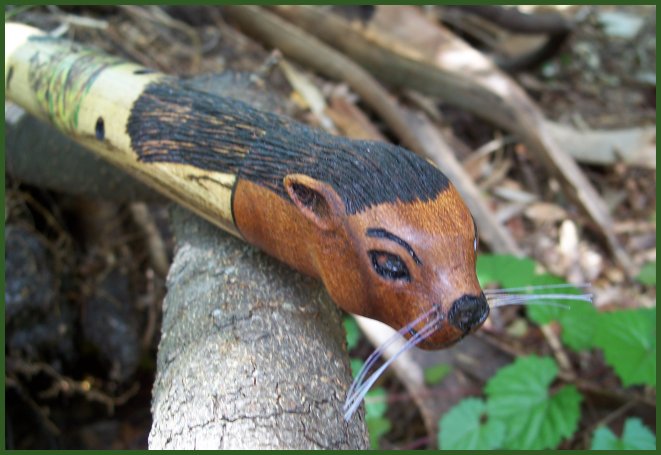
The carved head at the foot of this flute shows the man’s metamorphosis into the panther, exhibiting both human and cat characteristics (note especially the eyes, hair, and ears) .

This flute sits on a custom black walnut stand that holds a plaque that tells an abbreviated version of the legend, along with images from the legend and “Tluhdatsi Hawinaditluh Gadohi” (in the characters of the Cherokee syllabary) burned into the stand’s base.
This beautiful spalted hackberry flute is tuned to a deep, mellow D-minor pentatonic tuning. When viewing this flute, prominent are the carved mesquite prowling panther fetish and panther’s head at the foot. Images from the legend are burned and painted down the length of the flute, as described above. The lace holding the fetish to the nest is cut from deerskin. (March 2009).

(Uktena)
(Cherokee Mythological River Serpent)
This flute was created as my entry in the Flute Makers’ Competition at the 2008 Oklahoma Flute Festival (at the Cherokee Heritage Center in Park Hill, OK; October 3-5, 2008). There was no required theme for this contest’s entries, so I took this as an opportunity to create a flute I had envisioned while working on Kat Johnson’s “Uktena” flute (see below). So I chose the legend of how “Tlanuwa defeated Uktena” as the story I depicted on this flute. Uktena placed first in the competition.
How Tlanuwa Defeated Uktena
A Cherokee Legend
This is the ancient tale of Tlanuwa, the great mythic hawks, and Uktena, a giant, antler-horned, river-dwelling serpent with a great crystal (called the Ulun’suti) in the middle of its forehead.
Long before the white man came to these lands, a pair of Tlanuwa had their nest in a cave high on a rock cliff overlooking the river where the Uktena lived. The gigantic Tlanuwa flew up and down the river and, while passing over settlements, sometimes swooped down to carry away dogs or even small children. The people could not reach the nest, and arrows only glanced off their feathers. The desperate people sought the help of a medicine man. The medicine man made a long rope out of tree bark, and tied loops at the end for his feet. He had the people lower him down to the nest, which he reached with great difficulty. There he found four young birds, which he threw over the cliff into the deep river. The great Uktena rose to the surface and devoured the young birds. The Tlanuwa were very angry when they returned to see the Uktena taking the remains of their young down under the water. So they circled over the river until Uktena showed his head. The Tlanuwa dove straight down; one caught the serpent in its talons and lifted it into the sky while the other tore it to pieces. The Tlanuwa carried the tattered serpent high into the sky until they were no longer seen, and the people never saw them again.


The fetish depicts a “juvenile” Uktena rising from a hollow stump, his tail emerging below the flute and wrapping around the mouthpiece.

The head of the “adult” antler-horned Uktena emerges from the foot of the flute.
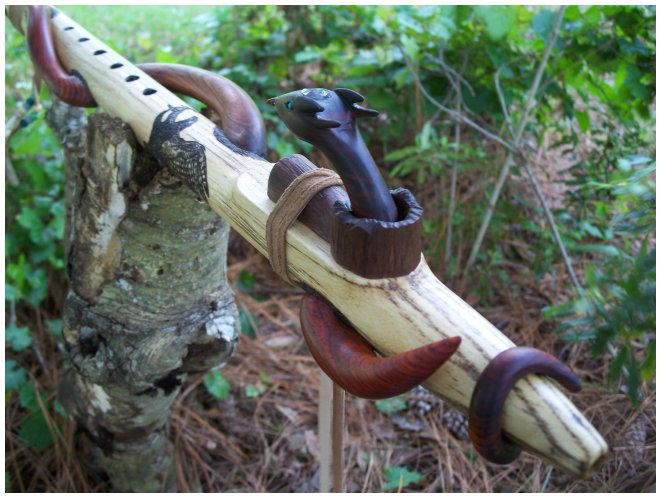
In this view, the “adult” Uktena‘s body weaves in and out along the length of the flute, the tail finally emerging from beneath the nest area and wrapping upward near the mouthpiece, just ahead of junior’s tail.
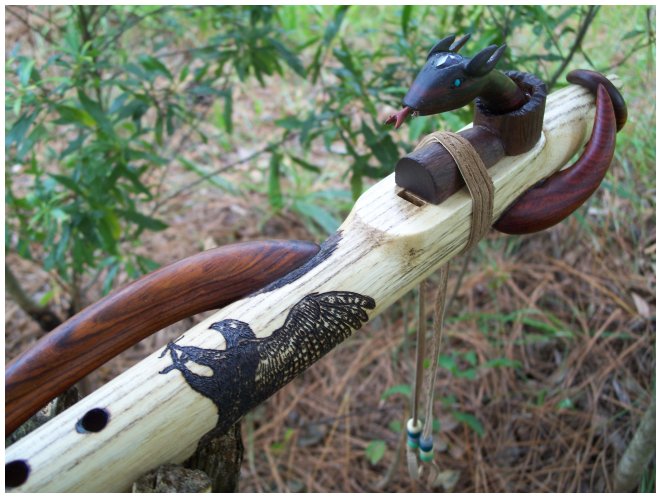
The gigantic Tlanuwa, talons extended, attacks Uktena‘s exposed body.

Here Uktena rests on his custom red cedar stand, the placard behind displaying the legend as told above.
This hackberry flute is tuned to a very mellow E-flat-minor pentatonic tuning. The fetish depicts a scene of a “juvenile” Uktena rising from a black walnut hollow stump. “Junior” is carved from South American cocobolo, including his immature antler-horns, with his bifid tongue from African padauk. his eyes are chips of turquoise and he has a small Ulun’suti (crystal) on his forehead. Junior’s body appears to be passing upward through the flute’s nest area, with his tail wrapping around the mouthpiece.
The head of the adult Uktena emerges from the foot of the flute. “Papa” is also carved from cocobolo with a padauk tongue, turquoise eyes, and a larger Ulun’suti on his forehead. Papa’s fully mature antler-horns are carved from South American tulipwood. Papa’s cocobolo body enters and leaves the body of the flute several times along the length of this flute, before his tail finally emerges near the mouthpiece.
The image of Tlanuwa, talons extended in final attack attitude toward papa’s exposed body, is burned into the flute’s body. In addition (painted imitation) hawk feathers representing Tlanuwa hang from a deerskin wrap near the foot of this flute.
The lace holding the fetish to the nest is cut from deerskin. (September 2008).

(Wadaduga)
(Cherokee for "Dragonfly")
This flute was created as my entry in the Flute Makers’ Competition at the 2008 Musical Echoes Flute Festival (Ft. Walton Beach, FL; April 25-27, 2008). The theme for that year’s festival was the dragonfly, and all competition entries were required to display the image of the dragonfly somewhere on the flute. I chose to use the flute to illustrate the Zuni legend of “The Boy and the Dragonfly“. This entry placed 3rd in this competition.
The Boy and the Dragonfly
A Zuni Legend
One time, long ago, the People were very unappreciative of their food, wasting it and throwing it around. So the Great Spirit decided to punish the People and sent the Corn Maidens away; the cornfields withered and died. The People became hungry and began suffering. Then, one day, a small boy was sitting at the edge of a dried up cornfield when he picked up a dried corn husk and fashioned a toy insect from it. When he finished, he tossed it out over the field and it suddenly came to life as a dragonfly, flying round and round over the dried up field. The dragonfly saw that the People were suffering and flew off to find the Corn Maidens to bring them back. When the Corn Maidens returned, the fields began growing again. The people were fed and were thankful, never again to disrespect their food. And the Great Spirit was again pleased with the People.
You can see the images from this story depicted in the photos of this flute below.
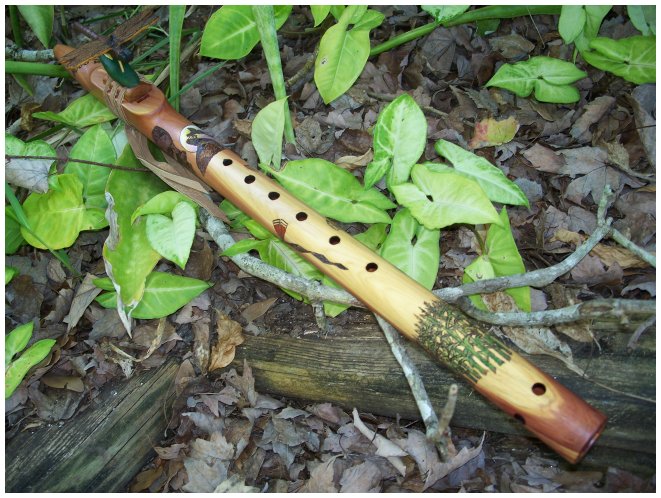

All entries had to show “ME 2008”

The boy with a dragonfly on his finger.



Symbolic Zuni dragonflies arise from the cornfield at the base. These dragonflies have wings inlayed with pink coral.
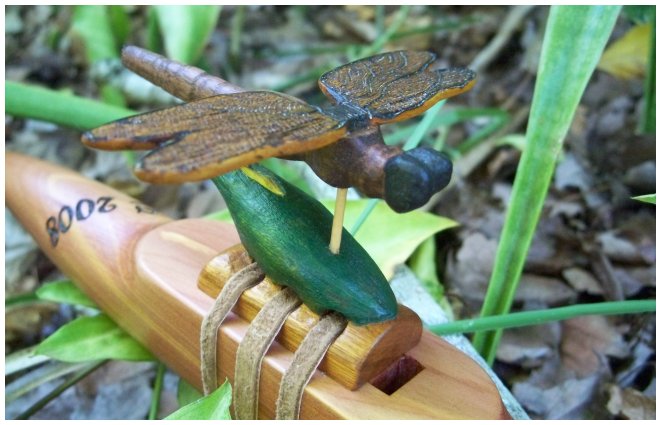
The fetish depicts the dragonfly returning over an abundant cornfield.
This aromatic eastern red cedar flute is tuned to a very mellow E-minor pentatonic tuning. The base and dragonfly wings of the fetish are canary wood, while the dragonfly body is black walnut. The corn is painted green and yellow, while the features of the wings are burned in. Following the Zuni legend, a cornfield is burned in around the base with painted corn stalks. The symbolic Zuni dragonflies that arise from the cornfield along either side of the sound holes are burned into the flute and inlayed with pink coral wings. The boy’s face has some subtle coloring that is painted, but is primarily burned in, as is his hand and the dragonfly sitting on his finger. The background sun is painted. The lace holding the fetish to the nest is cut from deerskin. (April 2008).
Custom Flutes for Customers
The following flutes were custom made to turn a customer’s vision into a very personal flute.
Sooty Tern


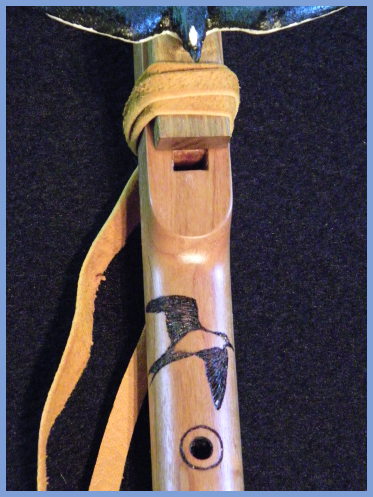



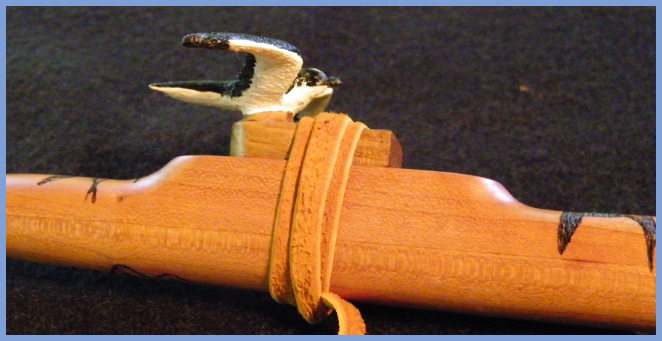
This custom cherry flute was made to fulfill a vision by my North Carolina friend Piro Papa. In accordance with Piro’s vision, it is tuned to the “high” E (E5) pentatonic minor scale, an octave higher that the typical “E” Native flute. This makes the flute small, with an overall diameter of under one inch and length just under 14 inches.
The theme for this little flute is the sooty tern, also called “wide awake”, which Piro explains is a little bird that lives an amazing life in which it never touches down on land or water for most of the year, until it is time to nest. The flute shows seventeen images of the bird in flight over the ocean, which is depicted by a large wave that wraps around the foot of the flute with inlay of crushed abalone for the foam at the wave crest and inlay of blue lapis and turquoise representing the water. The fetish is the sooty tern with wings extended in flight, carved from sassafras and painted in the bird’s colors – black on top and white on the bottom. (April 2014).
A soundclip from this flute:
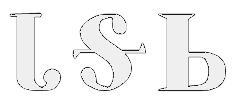
(Daksi)
Cherokee for "Turtle"
[Donated to the 2013 Native Rhythms Festival Silent Auction]




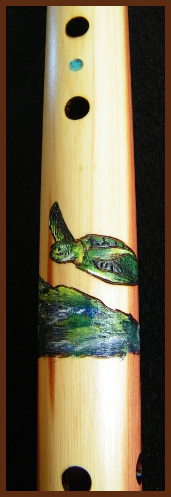
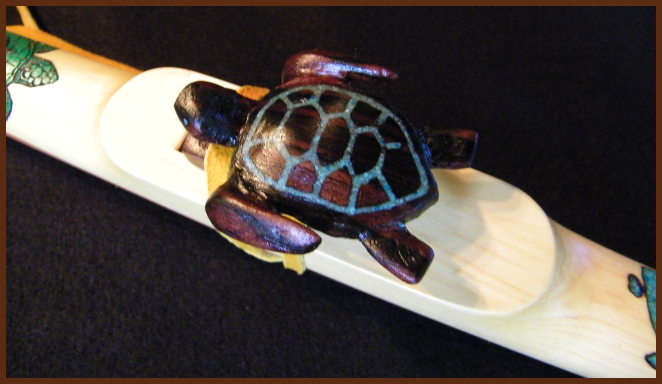
This aromatic eastern red cedar flute was made to donate to the 2013 Native Rhythms Festival silent auction. It is tuned to the Am pentatonic scale. The distinguishing characteristic of this custom flute is the incorporation of the festival’s 2013 logo burned and inlayed below the nest area. There is a turquoise inlay sea turtle at the mouth piece, and turquoise “button” inlays between the playing holes. Near the foot of this flute is an underwater scene featuring another sea turtle. The sea turtle fetish is carved from Southeast Asian mun ebony (sometimes called “moon” ebony), with turquoise inlay separating the plates on the turtle’s back and acting as the turtle’s eyes. The fetish is tied to the flute with a deerskin lace. (October 2013).
A soundclip from this flute:

(Nuhda ale Nuhda)
(Cherokee for "Sun and Moon")


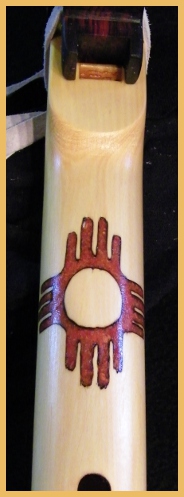

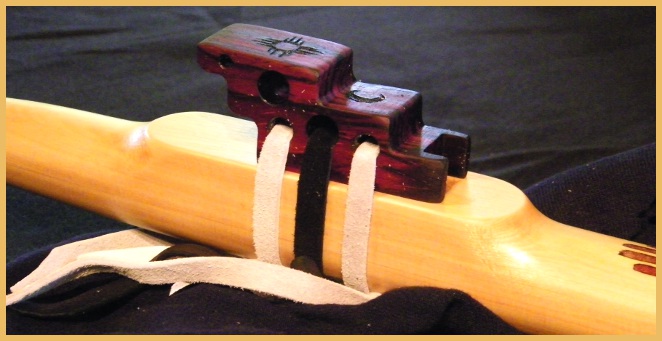
When a prospective customer wants a flute, not with an animal theme, but with the “sun and moon” as its theme, a little Internet search can turn up appropriate symbols. This Alaskan yellow cedar flute in the A-minor pentatonic tuning includes the Zia sun symbol (used on the New Mexico state flag) inlayed with Bali coral and a “tribal” moon symbol inlayed with crushed abalone shell and blue lapis. The fetish (block) consists of stepped blocks carved from South American cocobolo. On the top of the block are burned the Zia sun symbol and a crescent moon. (April 2011)
Orca/Eagle


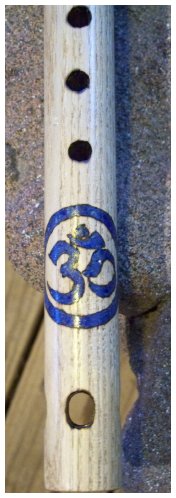
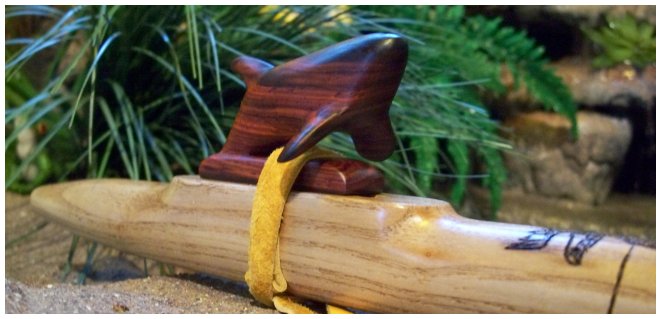
It’s hard to give a single name to this flute that was custom made for my good friend Gary Beckert because of the variety of symbols incorporated into the design of this flute. These images reflect Gary’s and his wife Reen’s personal symbols. The Orca (killer whale) fetish, rising from the water, carved from South American cocobolo is Gary’s animal totem, while the flying eagle burned into the flute below the nest area is Reen’s. The “OM” symbol inlayed with crushed blue lapis at the foot has special and “secret” significance to the couple. (“OM” is a mystical or sacred syllable in the Hindu, Jain, and Buddhist religions. It is placed at the beginning of most Hindu texts as a sacred exclamation to be uttered at the beginning and end of a reading of the Vedas or prior to any prayer or mantra.) This beautiful sassafras flute is tuned to the Am pentatonic scale. The lace holding the fetish to the nest is cut from tanned deerskin. (August 2008)
Peace Dragon
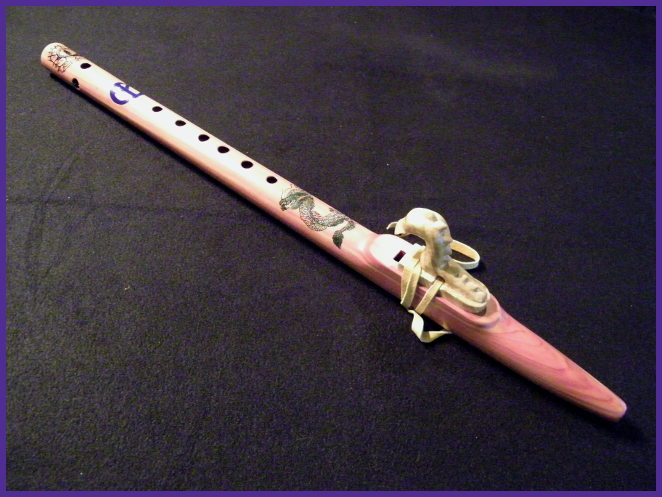

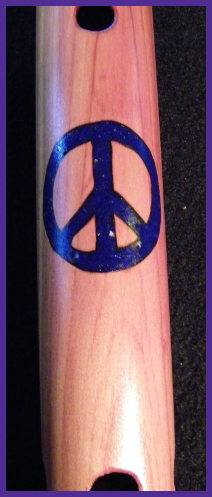

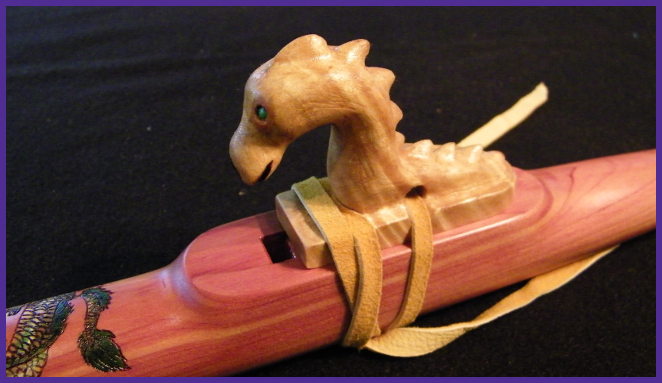
Kim from Ohio saw the “peace dragon” flute that I made for another customer, and wanted a variation on that design. Kim’s peace dragon is made from eastern red cedar, and is tuned to the Ab (A-flat) pentatonic minor scale. The dragon fetish is carved from silver maple and represents a dragon rising up out of the water. The fetish has little chips of turquoise eye inlays. The dragon image burned and painted in the area below the nest is in shades of green rather than blue on the other verson. The traditional peace symbol is done in blue lapis inlay. Adding her own touch, Kim requested a dragon’s eye at the foot of the flute. The lace holding the fetish to the nest is cut from tanned deerskin. ] (June 2017).
A soundclip from this flute:
"The Zoo"

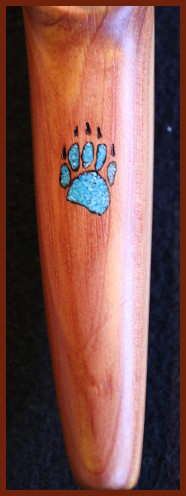



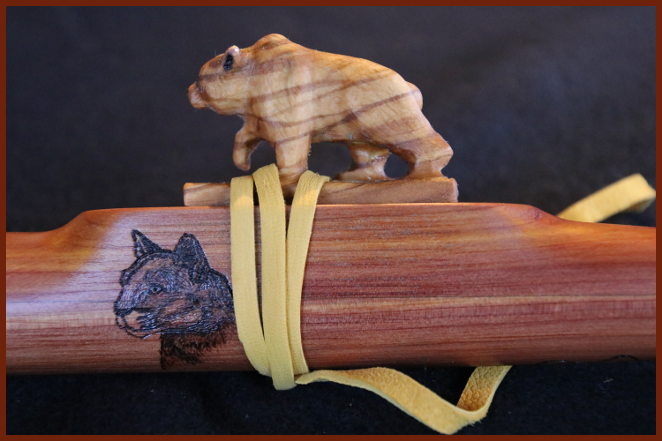

For this custom flute, I was asked to incorporate 6 animals into the artwork, each of significance to the customer: the bear, the wolf, the owl, the cougar, the hawk, and the sea turtle. For all of the animals on one flute, I lovingly call this flute “The Zoo”. It is made of eastern red cedar, and is tuned to the “G” pentatonic minor scale. The fetish is a prowling grizzly bear carved from olivewood, and a bear’s paw print appears at the mouthpiece as turquoise inlay. Just below the nest is the head of a howling timber wolf, howling up at a moon of inlay crushed abalone shell. Down between the bottom playing hole and the direction holes is a great horned owl, sitting on a fencepost. Then below that, below the direction holes, is a sea turtle. On one side of the nest area is the head of a red tail hawk, and on the other is a cougar’s head. Finally, the lace holding the fetish to the flute is cut from deerskin. (August 2018)
A soundclip from this flute:

(Daksi)
Cherokee for "Turtle"
[Custom Ordered "Winged Turtle"]



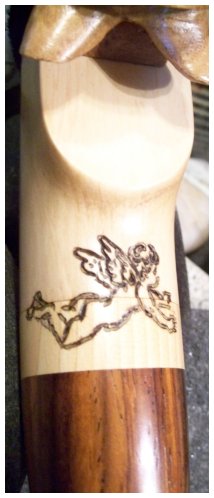
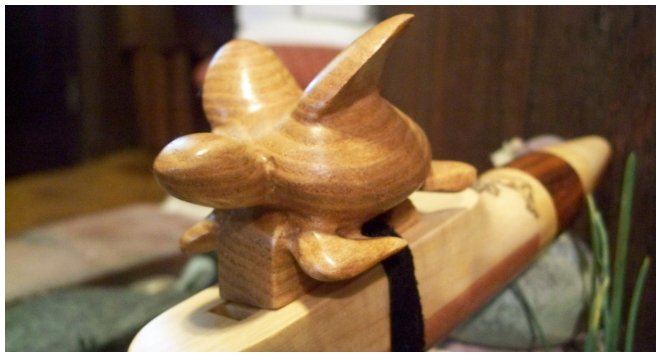
This aromatic eastern red cedar flute was custom ordered by a fellow in North Carolina to give to his girlfriend for Valentine’s Day. She loves turtles and angels, and he specifically requested a turtle with wings. It is tuned to the Gm pentatonic scale. The accent rings above the nest are Alaskan yellow cedar on either side of a wider South American cocobolo band. The ring near the foot (at the direction holes) is also yellow cedar. The “flying turtle” fetish is a sea turtle with little “angel wings” carved from sassafras. There is a sea turtle image burned into the flute body below the nest area. The turtle symbol burned in between the direction holes and the lowest finger hole has turquoise and pink coral inlay. There is also a pattern burned all around the back side at the level of this design. Just below this design is a woodlands wrap with beads and feathers at the end of the black-dyed deerskin wrap. The lace holding the fetish to the nest is also cut from black-dyed deerskin. The final touch in the images on this flute is a small angel just above the nest and drawn to be viewed by the player. (February 2008).

(Golanuh)
Cherokee for "Raven"
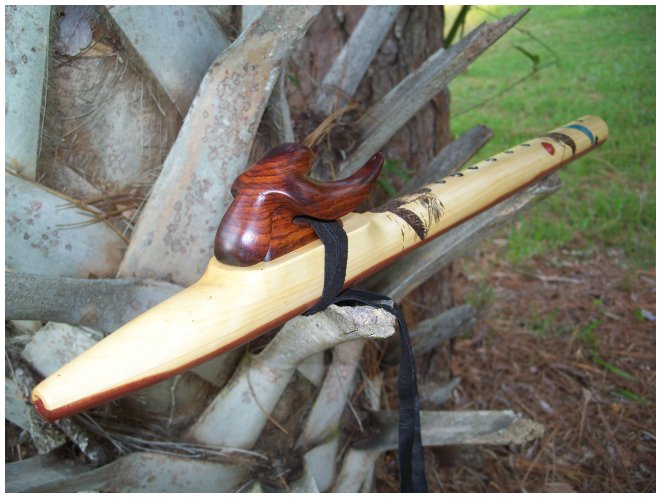

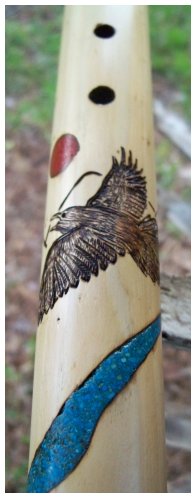

This aromatic eastern red cedar flute was custom made for Al Edwards, a Columbia, MO resident of Dakota Sioux heritage. The flute body has a very interesting color split that leaves the top half the lighter sapwood color and the bottom half the more common reddish heartwood tone. The raven fetish with forward stretching wings is carved from South American cocobolo. The very symbolic raven with a man’s reflection image is burned below the nest area, and a raven in flight appears at the foot of this flute. The flying raven is highlighted by a pink coral inlayed sun as he flies over an turquoise inlayed stream. The lace holding the fetish to the nest is cut from black-dyed deerskin. (June 2008).
The Golana Flute arrived yesterday morning, so I must now ask for your forgiveness for not replying sooner. But I have been totally lost within and to, its wondrous voice and exquisite exterior. This Flute is simply AMAZING. The second that I saw This Cedar Flute, I could feel The Breath of its Life, its Spirit (or as the Sioux say: its Woniya [Whoa-nee-yah] ) call out to me, with its demand to be Taken, Caressed and Held. When I did take it into my hands, I could feel the warmth and smell its breath, almost hearing its need to Speak.
It was as if, at long last, A lost part of me had been returned. For this is my Spirit Guide, and that Raven, has so much, to say.
This Fetish is the Flute, and it feels almost alive. All I need do is take the Golana into my hands, close my eyes and breath. And that Flute will start to sing as if that Ravin who is perched within that nest guides my breath. I can feel the air being withdrawn from my lungs and swept forward. The voice of this Flute is just, so Mellow and ALIVE – all I need do – is breath, and it sings and sighs. THEN, when it is fully supported with my diaphragm and tongue it’s throat and voice are simply breath taking. So heady – So strong – That I needed to take it from my lips, after only minutes of play ~ but couldn’t. For this is like NO other instrument that I have ever held or played. And you know my history…
Thank-You ~ John ~ Thank-You
(Al Edwards; Columbia, Missouri; 11 June 2008)
"Zuni Bear & Zia Sun"





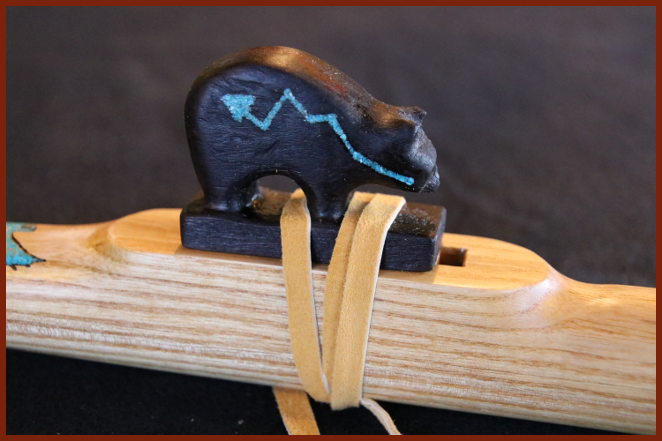
It’s not unusual to have a prospective customer come to me with an uncertain vision but with definite symbols that beckon. Such was the case with this custom flute for Susan. We settled on ash and cocobolo for the basic woods and the key of “F#” minor pentatonic. Then when it came time to tune it, she agreed on a Zuni bear with East Indian rosewood for the fetish, with the heart line of turquoise inlay. Finally everything was complete but the artwork. After further deliberation, we agreed on a turquoise inlay thunderbird at the mouthpiece, and an inlay Zia sun symbol, which I did in pink coral (synthetic, federal law prohibits the use of real pink coral), surrounded by four animals, one in each corner: a bear, a wolf, a sea turtle, and a bison. To honor her work with the elk, there is a prominent one down at the foot of the flute. The lace holding the fetish to the nest is cut from tanned deerskin. (August 2018).
A soundclip from this flute:
"Griffin"


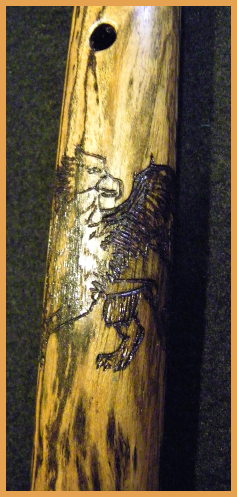
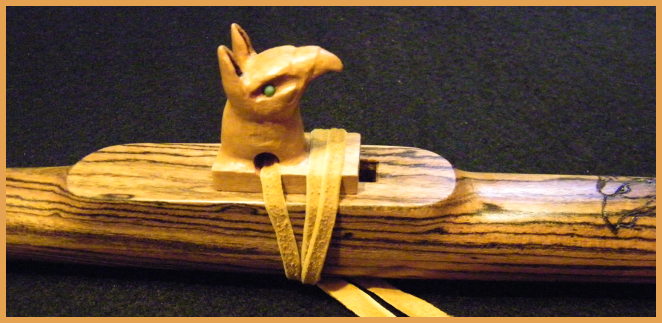
I was asked by a flute circle friend to create a flute with the “Griffin” theme from this piece of Central American bocote. At the time, I only had some vague visions of what a griffin is. So after a little research, I discovered that a griffin is a mythological beast with the upper body, including wings and forelegs, of an eagle, and the hind end, including tail, of a lion. As the eagle is considered by some to be the king of birds, and the lion the king of beasts, the griffin becomes the king of all creatures.
This flute is tuned to the F# pentatonic minor scale. Many griffin images I was able find showed the eagle’s head having large ears. So the fetish, carved from Osage Orange, includes ears. An image of the griffin’s head is also burned into the flute body just below the nest area. A full body griffin appears near the foot of the flute. Finally, the lace holding the fetish to the flute is cut from deerskin. (September 2017)
A soundclip from this flute:
"Horny Toad"




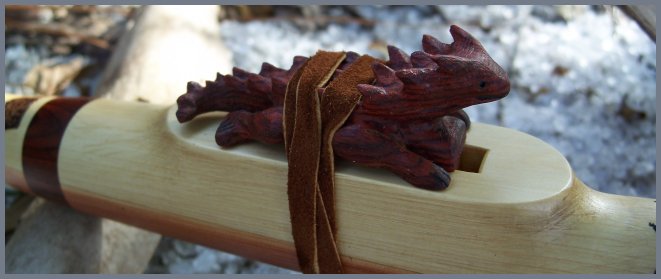
To appreciate the story behind this flute, first read the story of the first custom flute that Texan Judith Fesler ordered from us (the Nuhnohi Udeti – Roadrunner) about a year earlier. This time it was a flute for her husband, Warren. This flute would also be F#, but this one would be eastern red cedar with cocobolo mouthpiece and accent ring at the level of the direction holes, and the theme would be the “horny toad”. The fetish is also cocobolo and had to include the “horns” from which this lizard gets its name.
The scene near the foot of this flute was Judith’s personal request. The “horny toad” eats ants, and the one in the image is snacking on a few. But in the food chain, the “horny toad” is the prey of the roadrunner, Judith’s flute theme. So on the back side of this scene, a roadrunner stands in the background contemplating the “horny toad” before him.
Finally, the lace holding the fetish to the flute is cut from deerskin. (April 2009)
JOHN, THE HORNY TOAD FETISH SURPRISED BOTH OF US TODAY. AMAZING WHAT YOU CAN DO, ISN’T IT? THANK YOU FOR SEEING WARREN’S VISION AND COMPLETING IT FOR HIM. WE TRIED BOTH FLUTES TOGETHER EARLIER TODAY. THEY SOUND GREAT TOGETHER.
Judith Fesler; Kerrville, Texas; 22 April 2009

(Nuhnoh Udeti)
Cherokee for "Roadrunner"




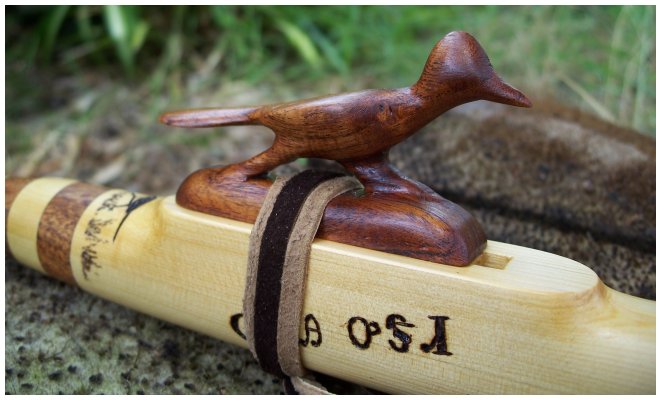
Texan Judith Fesler requested this custom roadrunner-themed flute in the key of F#m. The flute body is Alaskan yellow cedar with accent rings of tesota (sometimes called “desert ironwood”). The carved, running roadrunner fetish is also of tesota. Judith wanted the accent rings and fetish to be of the same wood (“Being a woman, I want matching things.”). Roadrunner images are burned into the body in three places, with a more elaborate scene near the foot with a rattlesnake and a pair of fuscite inlayed saguaro cacti. The sun beyond the hills is inlayed with pink coral. The two-tone deerskin laces were also specifically requested. (July 2008)
OH JOHN! IT IS JUST AWESOME. I LOVE THE RUNNING ROADRUNNER FETISH. AND THE SOUND IS CRISP AND CLEAR. OUTSTANDING JOB, JOHN. I AM VERY PLEASED WITH IT. THANK YOU FOR WORKING WITH ME AND MY DREAM. I HOPE TO HAVE MANY YEARS OF ENJOYMENT PLAYING IT. THANK YOU AGAIN!
Judith Fesler; Kerrville, Texas; 17 July 2008

(Kawonu)
Cherokee for "Duck"




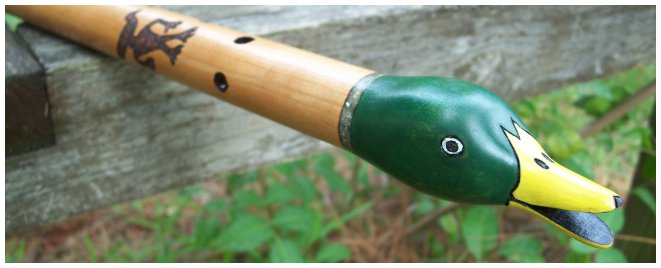
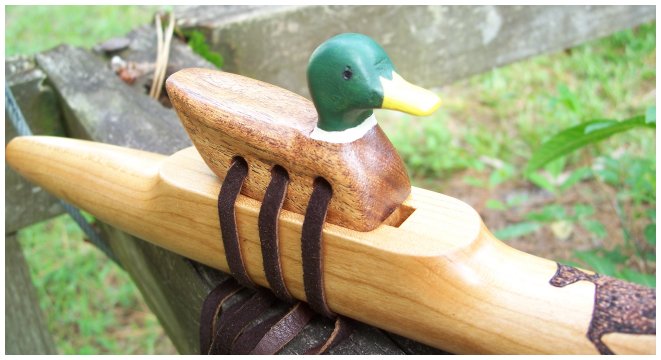
This flute was custom made for Kat Johnson (Utah). Kat’s husband is an archeologist and together they explore the mountains of Utah in search of ancient petroglyphs (rock paintings).
Although I call this flute Kawonu (Cherokee for “duck”), it is really a tribute to the legendary Zuni keeper of the creation story called Kiakklo, depicted in petroglyphs as a duck-headed man. According to legend, Kiakklo was sent to find a place for the Zuni to settle. When he became lost in a snowstorm, his voice cracked and made the sound of a duck. The duck hears his calls and guides him by the sound of the ceremonial shells worn around his neck. The deities decide that Kiakklo is to be the keeper of the creation story, but that duck must always accompany him. Kiakklo now returns every four years for the initiation of young boys, at which he chants the Zuni history (Chimikyanakowa).
Kawonu is made from a piece of black cherry that Kat’s son had been saving to make a gun stock, but sent to her to make into a flute instead. She entrusted that sentimental piece of wood to me with her vision of a flute honoring Kiakklo. The images were to be taken from photos that she had taken of petroglyphs on her outings.

From near Mexican Hat, Utah

From near Cedar City, Utah
This flute is tuned to the F# minor pentatonic scale. The carved mallard drake fetish is from mesquite. The Kiakklo and Kokopelli images burned into the body were lifted from photos that Kat provided (see above). The ring around the carved duck’s head at the foot of the flute is inlayed with crushed abalone shell, representative of the ceremonial shells worn by the duck in the Zuni legend. (July 2008).
What did Kat think of her special flute?
Kat Johnson; Ivins, Utah; 19 July 2008
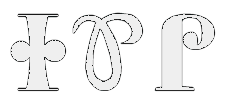
(Sogwili)
Cherokee for "Horse"
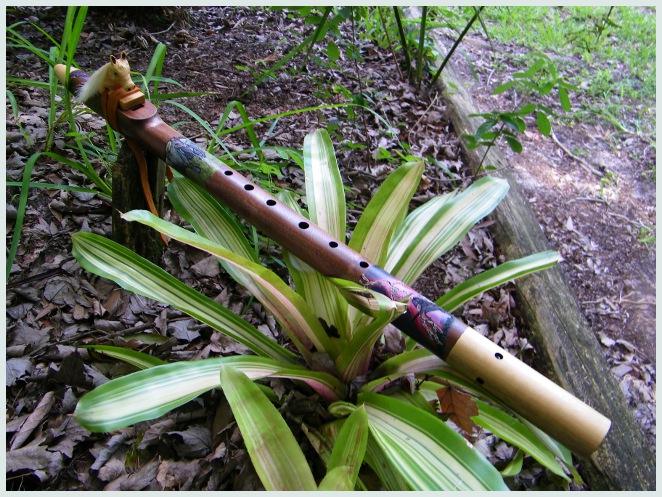
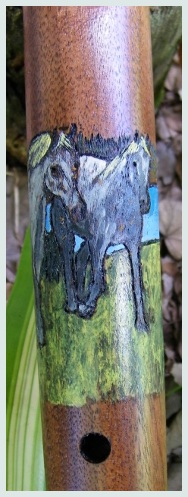

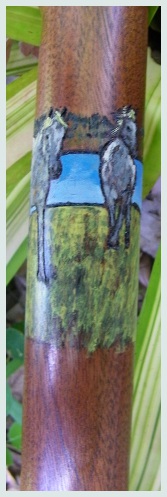
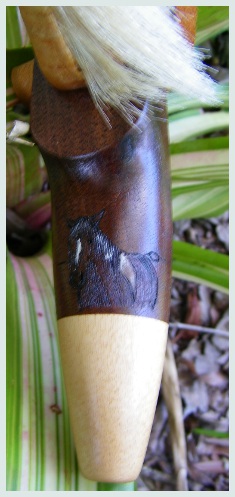



Gary Hage of Ocala, Florida (Florida’s horse country) asked me to make this beautiful E minor pentatonic flute in black walnut with a Oregon myrtlewood mouthpiece and extended endcap. The mane on the white ash horse’s head fetish is actual horse hair donated by my sister’s horse Ozzie. About this horse she says:
The ‘blonde’ hair came from my old Arabian gelding that I call Ozzie. His registered name is something like Azur Protent. He was born in California, in 1987 and I got him when he was 6 months old. He came along with me when I moved to Texas. His bloodlines are Russian, and he’s a big horse. Ozzie is a gray (almost white) horse. He was born brown, as most grays are, and as he aged he turned gray. Now, the old guy is almost totally white, except for a few blond spots on his mane and tail. He’s what I call a typical Arabian, ride them one day and they’re perfect, ride them the next day and they spook at every leave blowing in the wind. But, of all the horse breeds, their personality is closer to a dog’s than your standard horse.
Oh, a little story about Ozzie. When I first moved to Texas, I had him separated from the mares and foals in a pen by the front gate. To keep the gate open to drive in, we’d swing it back to Ozzie’s fence and hang a chain over the fence post. Well, Dad thought it would be cute to teach Ozzie how to take the chain off and close the gate for us. And, Dad did a good job teaching him. After you would open the gate, about the time you’d get back to the car, Ozzie had the gate pushed shut on you.
Gary is partial to Arabians and this flute is full of them! The scene between the nest area and the top hole wraps completely around the flute depicting four white Arabians running in front of a lake, while at the bottom of the flute is a horse rearing in silhouette in front of a massive lightning strike. A small horse’s head is also burned & painted just above the mouthpiece.
Flaws in a piece of wood can offer the maker the opportunity to further decorate a flute. In this case, rather than try to hide a worm track on the back side of the endcap, I chose to inlay the track with crushed turquoise, creating the effect in the above photo. There is also a small flaw on the backside of the mouthpiece, also filled with turquoise stone inlay. This all gives a flute its unique personality.
The lace holding the fetish to the nest is cut from deerskin. (June 2012)
A soundclip from this flute:
Kokopelli
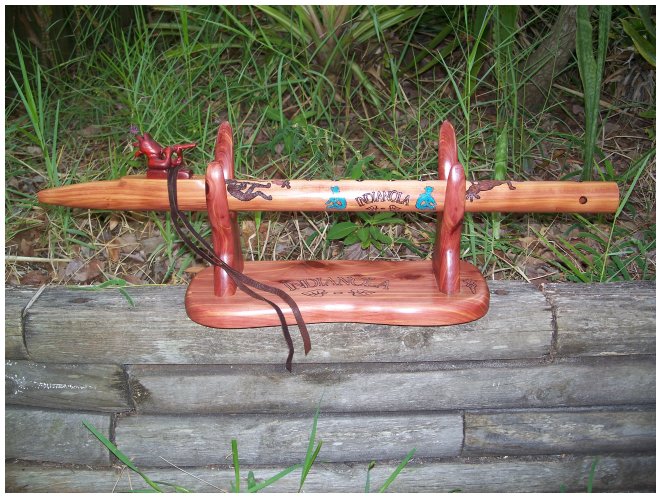




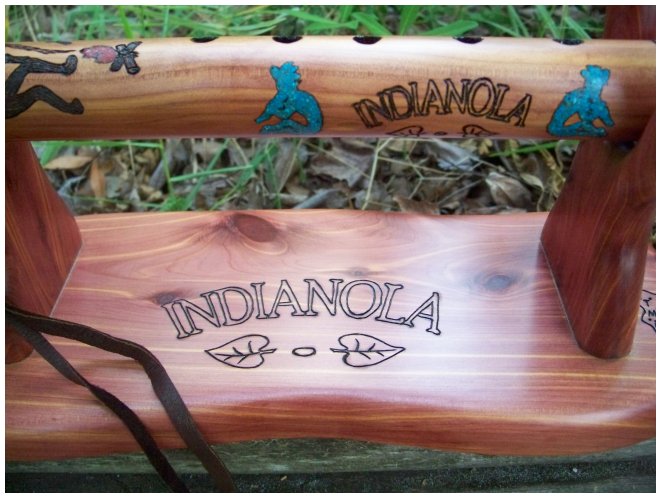
This aromatic eastern red cedar flute was custom ordered by Jay McMaster, the developer of the Indianola Condos, which sit adjacent to the west of the park in which the Musical Echoes festival is held each April. On the condo grounds is an ancient sacred mound, which has been retained in dignity and at which a ceremony is conducted during the Musical Echoes weekend. Jay asked me to make a Kokopelli-themed flute that honors Indianola, and that he can play over the mound.
The carved Kokopelli fetish is of South American padauk, and flute playing Kokopelli characters in various poses are burned into the body below the nest area and at the foot. The fire image is inlayed with pink coral, and the seated Kokopelli characters on either side of the “INDIANOLA” word are inlayed with turquoise. The lace holding the fetish to the nest is cut from a chocolate-brown dyed deerskin.
Jay also requested the custom flute stand, which is also made of aromatic eastern red cedar. (June 2008).

(Uktena)
(Cherokee Mythical River Serpent)
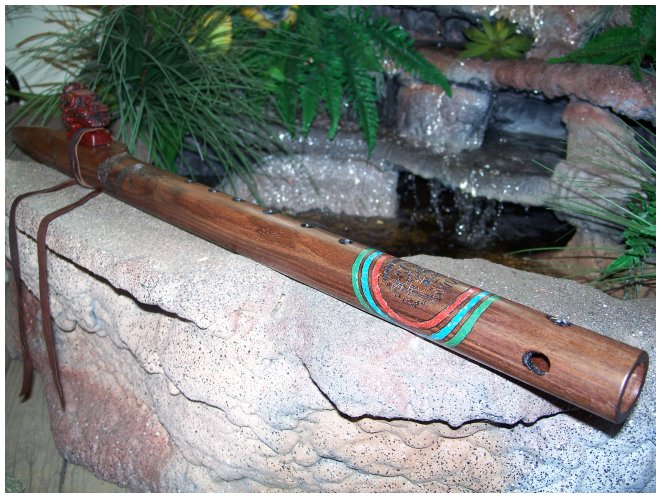
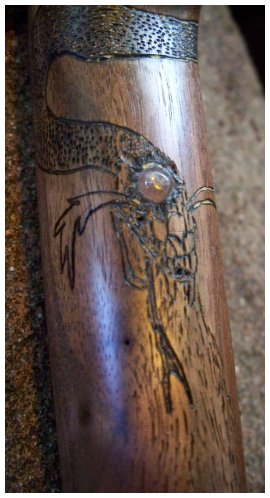
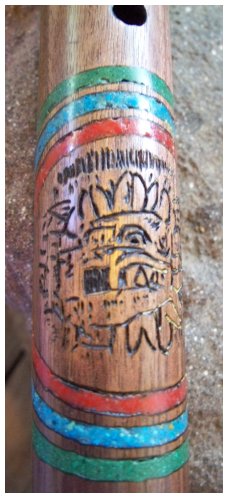
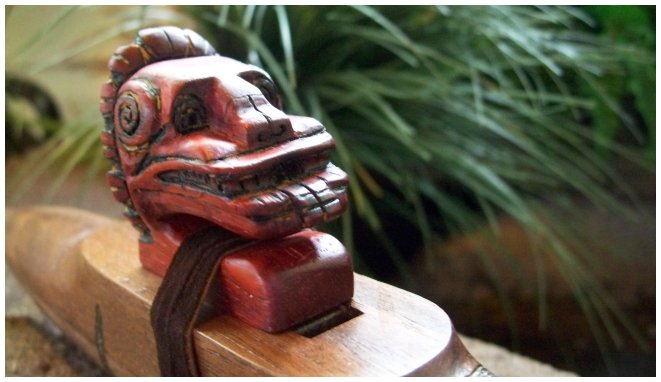
This black walnut flute was specially requested by Kat Johnson, a Utah enthusiast of Native American mythology and petroglyphs (rock paintings). She expressed specific interest in the feathered serpent (Quetzalcoatl) stone carving from Chichen Itza (on the Yucatan Peninsula), which is rendered in the carved African padauk fetish and burned in the body of the flute near the foot, and the Cherokee Uktena, a mythological river serpent, which is burned into the body below the nest and wrapping around the underside to the tip of the tail barely visible in the bottom photo above. You can see the Uluhsati (sacred crystal) inset in Uktena’s forehead. [One who possesses the Uluhsati is ensured success in hunting, love, rainmaking, etc. – and the ability to foretell life or death in the coming year.] There are also three rings inlayed around the Quetzalcoatl image at the foot, one each in pink coral, turquoise, and malachite. This flute is tuned to the Em pentatonic scale. (March 2008).
Kat’s reaction?
The Feathered Serpent just arrived, and let me tell you….I don’t like it………………………..I LOVE IT!!!! I hardly know what to say…I knew you were out-doing yourself and you did. It looks beautiful and plays beautiful too- completely in tune and very clear and responsive.
The design is great, and it was so much fun working with you. It is stunning, without being gaudy, and you had a better sense of enough is enough, and when to stop, than I did. It is just right, and I am sure of one thing- I’ll never see another one just like that! Friend Chris said, “Why didn’t someone think of that before?” Sure glad they did not.
Kat Johnson; Ivins, Utah; 4 April 2008
ECHOES from the TRAIL
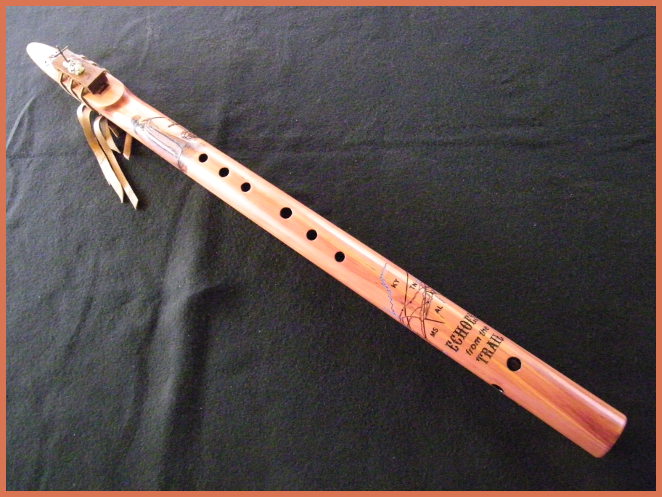
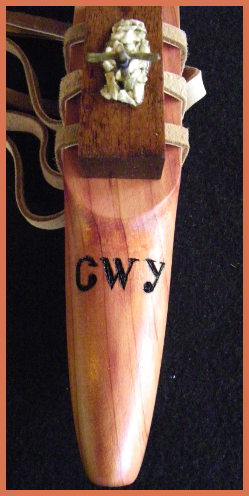
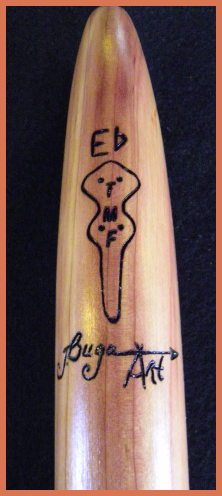
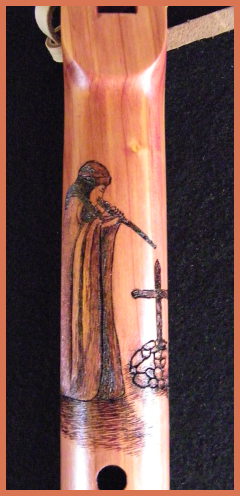
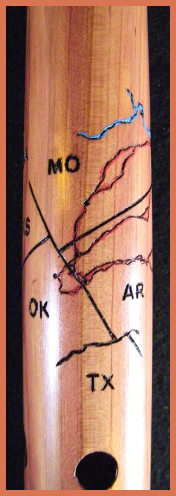



This aromatic eastern red cedar flute in Ebm (E-flat minor) was custom made for my dear friend Joyce Bugaiski. Joyce is an outstanding artist who agreed to do the cover art for a CD project I was working on as my alter-ego, Johnny Kee. I called the CD “ECHOES from the TRAIL”, referring to the Cherokee Removal of 1838-1839, remembered today as the “Trail of Tears”.
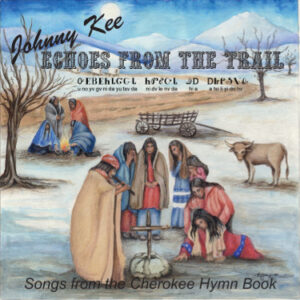 Between the stockades into which the Cherokee were rounded up, and along the almost 1000 miles of the trail, an estimated 4,000 of the 16,000 Cherokee died. When the deaths came while on the trail, a few friends and family members would hastily prepare a quick grave and briefly grieve for the lost loved one. Then they would have to catch up, because the procession didn’t stop. The cover art depicts a small group mourning over the grave, with a flute player playing over the grave. On this flute,. I’ve recreated Joyce’s image of the flute player and grave in pyrography.
Between the stockades into which the Cherokee were rounded up, and along the almost 1000 miles of the trail, an estimated 4,000 of the 16,000 Cherokee died. When the deaths came while on the trail, a few friends and family members would hastily prepare a quick grave and briefly grieve for the lost loved one. Then they would have to catch up, because the procession didn’t stop. The cover art depicts a small group mourning over the grave, with a flute player playing over the grave. On this flute,. I’ve recreated Joyce’s image of the flute player and grave in pyrography.
At the bottom of the flute is a map that wraps all the way around, showing the various routes that the “Trail of Tears” took across the various states. Most Cherokee were originally rounded up into stockades in the Chattanooga area in the extreme southeast of Tennessee (rightmost of the three map images above). They were held there during the hot summer of 1838. In the fall, groups of 650 to around 2,000 set out over various routes to make getting provisions along the way easier. The winter of 1838-39 was one of record cold, which contributed to the death of many of the people. Even Principal Chief John Ross lost his wife after she gave up her blanket to a cold child. The trail ended at Tahlequah in Indian Territory, present day eastern Oklahoma (leftmost of the three map images)..
The fetish is a block with a “grave” on top. The cross is made from live oak twigs. The laces holding the fetish are cut from deerskin.
I’ve included Joyce’s JBugaArt logo along with the Turtle Mound Flutes logo on the back of the flute in respect to her original artwork from which I created the flute player image. (June 2016).
A soundclip from this flute:

(Tsalagi Tsuniyuhwi)
(Cherokee for "Cherokee Clans")
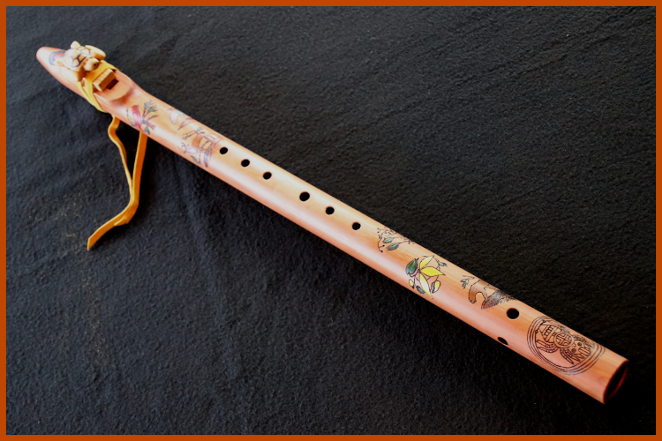
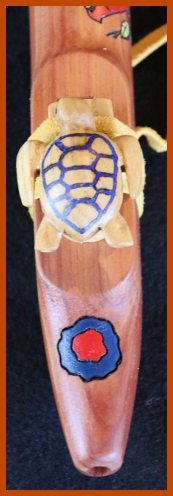
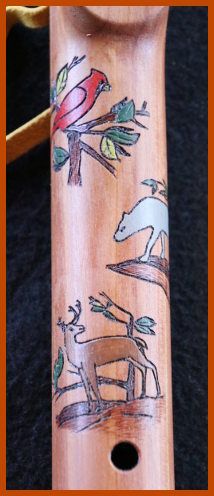

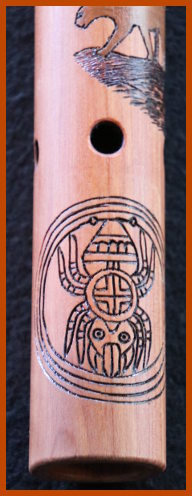

Ani-Wodi (Paint Clan)

Ani-Jisqua (Bird Clan)
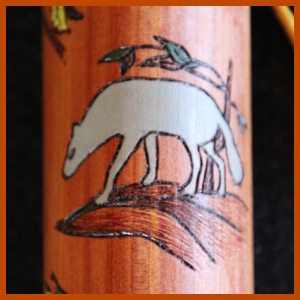
Ani-Waya (Wolf Clan)

Ani-Ahwi (Deer Clan)
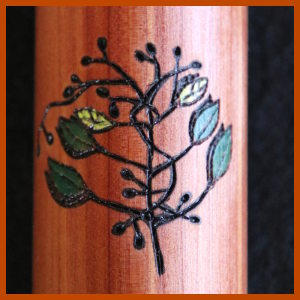
Ani-Gilohi (Long Hair Clan)
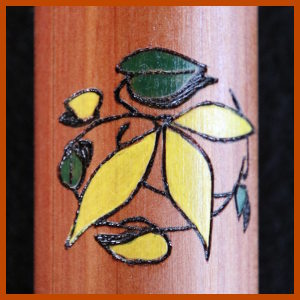
Ani-Gatogewi (Wild Potato Clan)
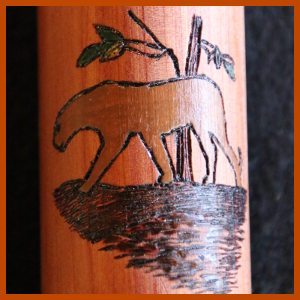
Ani-Sahoni (Blue Clan –
also known as the Panther Clan)

This aromatic eastern red cedar flute in the key of D-minor was custom made for Myles Wood (Baltimore) to honor the seven Cherokee Clans (Tsalagi Tsuniyuhwi). Symbols representing the seven clans are burned and painted into the flute body. At the foot of the flute is a symbolic water spider, in the style found etched into shells. According to Cherokee legend, the little female water spider is revered as the one animal who could deliver fire to the people after all other animals had failed. The turtle fetish is carved from Ash and incorporates blue lapis inlay. The lace holding the fetish to the nest is cut from a tanned deerskin. (April 2019).
A soundclip from this flute:
Pochteca Trader

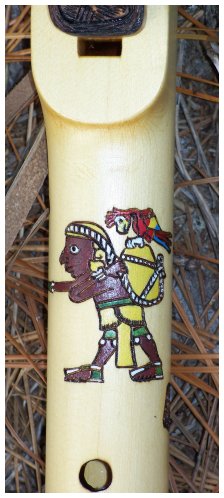
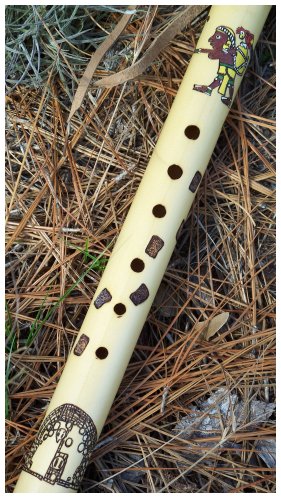


Our most loyal supporter, Kat Johnson of Ivins, UT, ordered this, her third custom flute from us, as her “vision flute.” This mellow D flute is Alaskan yellow cedar with a padauk mouthpiece and endcap. The “sandal” fetish is carved and burned from silver maple.
Along with her archeologist husband Boma, Kat is enthusiastic about the ancient peoples of what is now the southwest U.S. I’ll let Kat describe the abundant symbology on this flute for you…
Between AD 900 and 1150, Chaco Canyon was a major center of culture for the Ancestral Puebloans (also known as the “Anasazi“). The Chacoans quarried sandstone blocks and hauled timber from great distances, assembling fifteen major complexes which remained the largest buildings in North America until the 19th century. There is evidence of sophisticated archaeoastronomy at Chaco, with the “Sun Dagger” petroglyph at Fajada Butte a well known example. Many Chacoan buildings were aligned to capture the solar and lunar cycles, requiring generations of astronomical observations and centuries of skillfully coordinated construction. Both political upheaval and climate change led to the eventual abandonment of the canyon, beginning with a 50-year drought in 1130. Many modern Pueblo people trace their ancestry to Chaco Canyon.
The massive Pueblo Bonito complex was built in the 10th Century, as both a trading and ritual center. Pueblo Bonito is divided into two sections by a precisely aligned wall, running north to south, through the central plaza. A Great Kiva is placed on either side of the wall, creating a symmetrical pattern common to many of the Great Houses. Interior living spaces were quite large by the standards of the Ancient Pueblo. The site covers almost two acres and incorporates at least 600 to 800 rooms, In some parts of Pueblo Bonito, the tiered structure was four and five stories high. Most of the rooms in Pueblo Bonito were used for storage of trade goods, rather than permanent dwellings. The image of Pueblo Bonito is burned into the bottom area between direction holes and “bottom” finger hole.
Chaco Canyon was a trading center in a network of centers, roads and trails extending down to Mexico and back. Turquoise was mined in New Mexico and Nevada, and brought to Chaco Canyon for processing into beads and other trade objects. The Mesoamerican Pochteca Traders brought goods such as shell and macaws north to Chaco Canyon to exchange for turquoise. That is why the image at the top area between nest and “top” finger hole is that of the Pochteca Trader, with his burden basket and scarlet macaw. The fetish is a detailed trader’s sandal, and his sandaled footprints wind around the length of the flute, representing his long journeys.
Culture, stories and ideas are spread by people, and people love to travel, both then and now. The Mesoamerican Pochteca may have been the origin of the Kokopelli figure in rock art- not a with a “humped back” at all, but a burden basket full of goodies for trade. The Pochteca traders played their flutes to announce their arrival at villages along their routes. And, in reference to the intensely male physical appearance of Kokopelli, the traders would have been very happy, after a long journey, to arrive at the pueblos and see the ladies there!
Kat Johnson; Ivins, Utah; December 2008
(December 2008).
Metamorphosis
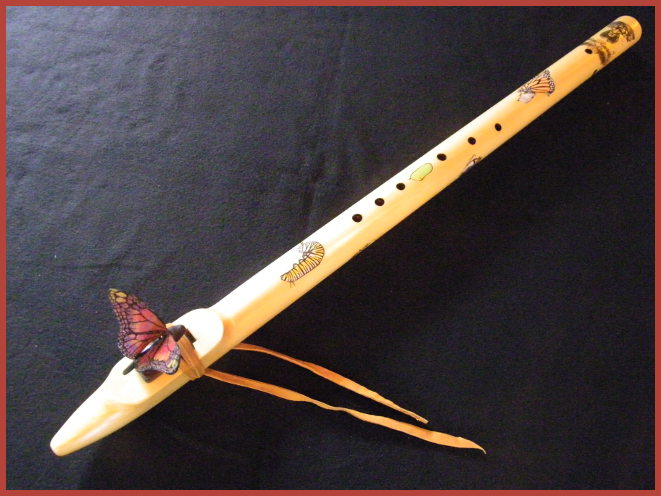
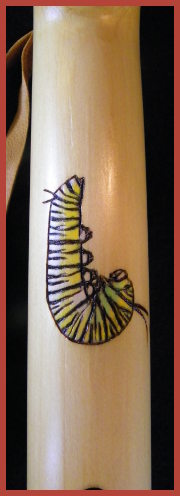
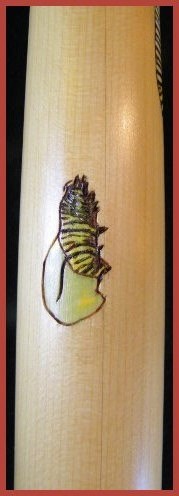


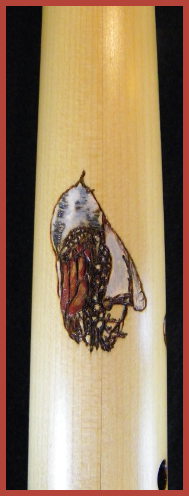
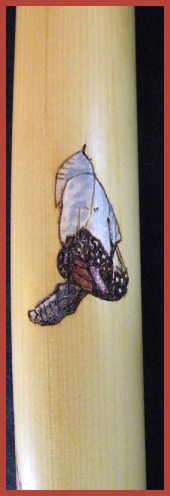

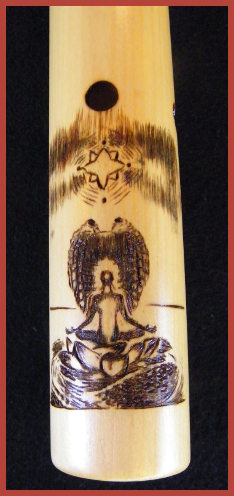
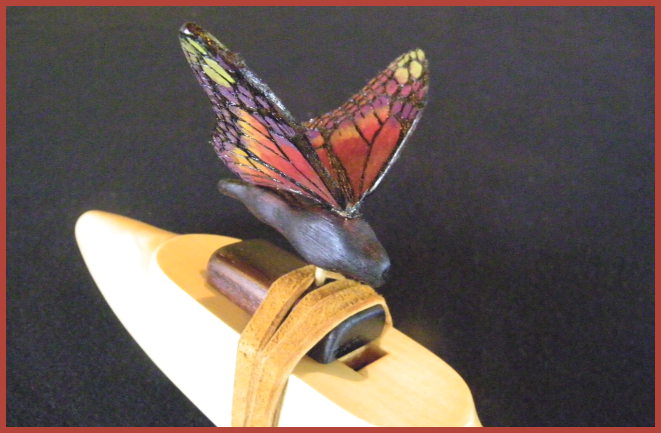
This flute is another arising from the imagination of my loyal supporter Piro in North Carolina. He asked me to create a flute depicting the concept of metamorphosis, and immediately I saw this as the classic example of a caterpillar changing into a butterfly. This Alaskan yellow cedar tuned to the “mid” C pentatonic minor scale was the result. [NOTE: Many people call this a “low C” but the fundamental is actually the bottom note of the “mid” range scale.] The fetish is made of three woods: the base is cocobolo, the butterfly body is ebony, and the wings are thin slices of sassafras, decorated with pyrographic outlines and colorful acrylics. Piro insisted that the wings be angle up at 45 degree angles. Starting just below the nest and working around the flute body downward to just above the direction holes are 7 images of the metamorphosis of the caterpillar at the top to the newly emerged monarch butterfly at the bottom, depicting the creation of the cocoon and the gradual escape of the butterfly from it. The image at the very foot of the flute was provided by Piro, representing his concept of metamorphosis. The lace is cut from tanned deerskin. (October 2015).